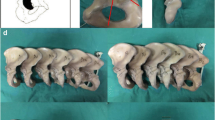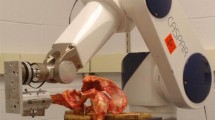Abstract
Purpose
Although studies suggest that subchondral insufficiency fracture of the femoral head may cause rapidly progressive osteoarthritis of the hip, the mechanism of that relationship remains unclear. Our biomechanical study aimed to provide more data in this area by quantifying pressure distribution on the femoral head for normal and inverted hips and by determining the effects of labral inversion on pressure distribution across the joint, focusing on types of fracture under load.
Methods
We tested mid-sized fourth-generation composite femurs at 15° of adduction, and applied 1 mm/min of axial compressive force to the femoral heads until failure. Additionally, single loads (3000 N) were applied using Prescale film to investigate pressure distribution on the femoral head, with or without silicone rubber representing entrapment of an inverted acetabular labrum.
Results
In tests with an external load of 3000 N, the mean pressure for 10 × 5 mm of silicone rubber was 11.09 MPa, significantly greater (about 5.7-fold) than 1.94 MPa without silicone rubber. Different fracture patterns were observed with and without the 10 × 5 mm silicone rubber; when the 10 × 5 mm silicone rubber specimens were used, all eight cases showed fractures in the anterior femoral head.
Conclusions
When silicone rubber representing an inverted acetabular labrum was placed between a hemispherical metallic platen and a composite bone model, the silicone rubber areas were subjected to extreme concentration of stress. The fractures that developed at the silicone rubber areas clearly represented subchondral fractures of the femoral head, rather than fractures of the femoral neck.






Similar content being viewed by others
References
Kim SM, Oh SM, Cho CH, Lim SJ, Moon YW, Choi SH, Park YS (2016) Fate of subchondral fatigue fractures of femoral head in young adults differs from general outcome of fracture healing. Injury 47:2789–2794. https://doi.org/10.1016/j.injury.2016.10.014
Buttaro M, Della Valle AG, Morandi A, Sabas M, Pietrani M, Piccaluga F (2003) Insufficiency subchondral fracture of the femoral head: report of 4 cases and review of the literature. J Arthroplast 18:377–382. https://doi.org/10.1054/arth.2003.50092
Yamamoto T, Nakashima Y, Shuto T, Jingushi S, Iwamoto Y (2007) Subchondral insufficiency fracture of the femoral head in younger adults. Skelet Radiol 36:S38–S42. https://doi.org/10.1007/s00256-006-0178-1
Motomura G, Yamamoto T, Miyanishi K, Shirasawa K, Noguchi Y, Iwamoto Y (2002) Subchondral insufficiency fracture of the femoral head and acetabulum: a case report. J Bone Joint Surg Am 84:1205–1209
Song WS, Yoo JJ, Koo KH, Yoon KS, Kim YM, Kim HJ (2004) Subchondral fatigue fracture of the femoral head in military recruits. J Bone Joint Surg Am 86:1917–1924
Kobayashi H, Ito N, Akiyama T, Okuma T, Kinoshita Y, Ikegami M, Shinoda Y, Fukumoto S, Tanaka S, Kawano H (2017) Prevalence and clinical outcomes of hip fractures and subchondral insufficiency fractures of the femoral head in patients with tumour-induced osteomalacia. Int Orthop 41(12):2597–2603. https://doi.org/10.1007/s00264-017-3610-3
Postel M, Kerboull M (1970) Total prosthetic replacement in rapidly destructive arthrosis of the hip joint. Clin Orthop Relat Res (72):138–144
Lequesne M (1970) Rapid destructive coxarthritis. Rhumatologie 22:51–63
Flemming DJ, Gustas-French CN (2017) Rapidly progressive osteoarthritis: a review of the clinical and radiologic presentation. Curr Rheumatol Rep 19(42). https://doi.org/10.1007/s11926-017-0665-5
Bangil M, Soubrier M, Dubost JJ, Rami S, Carcanagus Y, Ristori J, Burriere J (1996) Subchondral insufficiency fracture of the femoral head. Rev Rhum Engl Ed 63:859–861. https://doi.org/10.1002/1529-0131(199912)42:12
Yamamoto T, Bullough PG (1999) Subchondral insufficiency fracture of the femoral head: a differential diagnosis in acute onset of coxarthrosis in the elderly. Arthritis Rheum 42:2719–2723. https://doi.org/10.1002/1529-0131(199912)42:12<2719::AID-ANR31>3.0.CO;2-X
Hagino H, Okano T, Teshima R, Nishi T, Yamamoto K (1999) Insufficiency fracture of the femoral head in patients with severe osteoporosis: report of 2 cases. Acta Orthop Scand 70:87–89
Rafii M, Mitnick H, Klug J, Firooznia H (1997) Insufficiency fracture of the femoral head: MR imaging in three patients. AJR 168:159–163
Yamamoto T, Bullough PG (2000) The role of subchondral insufficiency fracture in rapid destruction of the hip joint. Arthritis Rheum 43:2423–2327. https://doi.org/10.1002/1529-0131(200011)43:11<2423::AID-ANR8>3.0.CO;2-Z
Yamamoto T, Takabatake K, Iwamoto Y (2002) Subchondral insufficiency fracture of the femoral head resulting in rapid destruction of the hip joint: a sequential radiographic study. AJR Am J Roentgenol 178:435–437
Watanabe W, Itoi E, Yamada S (2002) Early MRI findings of rapidly destructive coxarthrosis. Skelet Radiol 31:35–38. https://doi.org/10.1007/s00256-001-0445-0
Davies AM, Bradley SA (1991) Iliac insufficiency fractures. Br J Radiol 64:305–309. https://doi.org/10.1259/0007-1285-64-760-305
Lin J, Lachmann E, Nagler W (2001) Sacral insufficiency fractures: a report of two cases and a review of the literature. J Womens Health Gend Based Med 10:699–705. https://doi.org/10.1089/15246090152563588
Verhaegen MJ, Sauter AJ (1999) Insufficiency fractures, an often unrecognized diagnosis. Arch Orthop Trauma Surg 119:115–116
Fukui K, Kaneuji A, Fukushima M, Matsumoto T (2014) Inversion of the acetabular labrum triggers rapidly destructive osteoarthritis of the hip: representative case report and proposed etiology. J Arthroplast 29:2468–2472. https://doi.org/10.1016/j.arth.2014.06.017
Fukui K, Kaneuji A, Fukushima M, Matsumoto T (2015) Early MRI and intraoperative findings in rapidly destructive osteoarthritis of the hip: a case report. Int J Surg Case Rep 8:13–17. https://doi.org/10.1016/j.ijscr.2015.01.009
Fukui K, Kaneuji A, Fukushima M, Matsumoto T (2014) Imaging and histopathological evaluation of a cystlike formation in subchondral insufficiency fracture of the femoral head: a case report and literature review. Int J Surg Case Rep 5:324–329. https://doi.org/10.1016/j.ijscr.2014.03.024
Gardner MP, Chong AC, Pollock AG, Wooley PH (2010) Mechanical evaluation of large-size fourth-generation composite femur and tibia models. Ann Biomed Eng 38:613–620. https://doi.org/10.1007/s10439-009-9887-7
Heiner AD (2008) Structural properties of fourth-generation composite femurs and tibias. J Biomech 41:3282–3284. https://doi.org/10.1016/j.jbiomech.2008.08.013
Smith CD, Masouros S, Hill AM, Amis AA, Bull AM (2009) A biomechanical basis for tears of the human acetabular labrum. Br J Sports Med 43:574–578. https://doi.org/10.1136/bjsm.2008.053645
Takahashi E, Kaneuji A, Tsuda R, Numata Y, Ichiseki T, Fukui K, Kawahara N (2017) The influence of cement thickness on stem subsidence and cement creep in a collarless polished tapered stem: when are thick cement mantles detrimental? Bone Joint Res 6:351–357. https://doi.org/10.1302/2046-3758.65.BJR-2017-0028.R1
Wijdicks CA, Balldin BC, Jansson KS, Stull JD, Laprade RF, Philippon MJ (2013) Cam lesion femoral osteoplasty: in vitro biomechanical evaluation of iatrogenic femoral cortical notching and risk of neck fracture. Arthroscopy 29:1608–1614. https://doi.org/10.1016/j.arthro.2013.06.021
Yoshikawa T, Turner CH, Peacock M et al (1994) Geometric structure of the femoral neck measured using dual-energy x-ray absorptiometry. J Bone Miner Res 9:1053–1064. https://doi.org/10.1002/jbmr.5650090713
Crawford MJ, Dy CJ, Alexander JW et al (2007) The 2007 Frank Stinchfield Award. The biomechanics of the hip labrum and the stability of the hip. Clin Orthop Relat Res 465:16–22
Ferguson SJ, Bryant JT, Ganz R, Ito K (2003) An in vitro investigation of the acetabular labral seal in hip joint mechanics. J Biomech 36:171–178
Ferguson SJ, Bryant JT, Ganz R, Ito K (2000) The influence of the acetabular labrum on hip joint cartilage consolidation: a poroelastic finite element model. J Biomech 33:953–960
Ferguson SJ, Bryant JT, Ganz R, Ito K (2000) The acetabular labrum seal: a poroelastic finite element model. Clin Biomech (Bristol, Avon) 15:463–468
Jo WL, Lee WS, Chae DS, Yang IH, Lee KM, Koo KH (2016) Decreased lumbar lordosis and deficient acetabular coverage are risk factors for subchondral insufficiency fracture. J Korean Med Sci 31:1650–1655. https://doi.org/10.3346/jkms.2016.31.10.1650
Nicayenzi B, Shah S, Schemitsch EH, Bougherara H, Zdero R (2011) The biomechanical effect of changes in cancellous bone density on synthetic femur behavior. Proc Inst Mech Eng H 225:1050–1060
Smith SD, Jansson KS, Philippon MJ, LaPrade RF, Wijdicks CA (2014) Fracture mechanics of the femoral neck in a composite bone model: effects of platen geometry. J Biomech 447:602–606. https://doi.org/10.1016/j.jbiomech.2013.10.042
Basso T, Klaksvik J, Syversen U, Foss OA (2014) A biomechanical comparison of composite femurs and cadaver femurs used in experiments on operated hip fractures. J Biomech 47:3898–3902. https://doi.org/10.1016/j.jbiomech.2014.10.025
Nakano N, Yip G, Khanduja V (2017) Current concepts in the diagnosis and management of extra-articular hip impingement syndromes. Int Orthop 41:1321–1328. https://doi.org/10.1007/s00264-017-3431-4
Acknowledgments
We thank Lee Seaman of Seaman Medical, Inc. (Bellingham, WA, USA) for providing the professional English-language editing of this article.
Funding
This research did not receive any specific grants from funding agencies in the public, commercial, or not-for-profit sectors.
Author information
Authors and Affiliations
Corresponding author
Ethics declarations
Conflict of interest
The authors declare that they have no conflict of interest.
Ethical approval
This article does not contain any studies with human participants or animals performed by any of the authors.
Rights and permissions
About this article
Cite this article
Wang, X., Fukui, K., Kaneuji, A. et al. Inversion of the acetabular labrum causes increased localized contact pressure on the femoral head: a biomechanical study. International Orthopaedics (SICOT) 43, 1329–1336 (2019). https://doi.org/10.1007/s00264-018-4266-3
Received:
Accepted:
Published:
Issue Date:
DOI: https://doi.org/10.1007/s00264-018-4266-3




